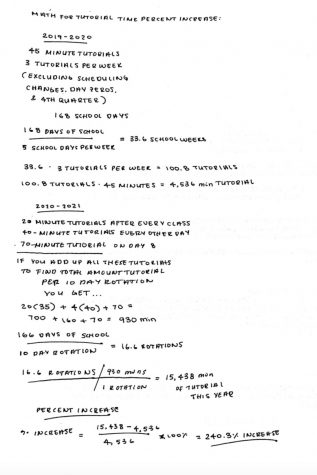Pandemic Forces School Schedule Changes, Teachers Reflect on Curricula
Teachers have had to take into consideration both the 26% decrease in class time as well as the 240% increase in tutorial time due to scheduling changes. “If you’re going to understand something, either on Zoom or in class, it has to be to a certain level,” math and computer science teacher Zachary Blickensderfer said. Staff illustration: Sophie Fang.
February 6, 2021
Changes to the schedule this school year have provided teachers the opportunity to reflect on their curriculum. In general, teachers are working with about three-fourths of the amount of class time that they have had in previous years. With less total class time, teachers have been debating not only the quality of the content versus the quantity they can teach but also whether to prioritize skill over content.
Because of the change in schedule, each class will meet for just 4,980 minutes of class time this school year, a 26% decrease from a typical school year’s 6,720 minutes, according to Upper School Director John Schafer. However, because of the addition of sectional tutorial periods, students will have 15,438 minutes of tutorial during the 2020-21 school year, a 240% from a typical year’s 4,536 minutes.
English Department Chair Margaret Ramsey has seen these scheduling changes affect her curriculum. “Even the difference of ten minutes [per class period] makes us think differently about how a class runs,” Ramsey said.
The changes in class time and learning quality is not only a direct effect of scheduling changes but also a byproduct of distance learning. “Sixty minutes over Zoom is definitely not the same as 60 minutes of in-person instruction,” Science Department Chair James Formato said.
Teachers have had to actively work to adjust to the reduction of class time. “In the science department, teachers worked all summer [to adapt to distance learning]. We hardly took any time off,” Formato said. Within his own physics course, Formato has had to adapt the depth to which students learn certain topics. “What we’re omitting is a lot of the finer detail,” Formato said. “We’re really concentrated on big picture themes.”
Despite these significant changes, most teachers have kept a positive and growth-centered mindset.“From what I’ve observed I think a lot of English teachers are treating this year as its own thing,” Ramsey said. Math and computer science teacher Zachary Blickensderfer agreed with this. “The big questions I was asking myself were [not only] ‘What makes sense to leave out?’ but also ‘In what ways do I want to approach teaching differently?’” Blickensderfer said.
The changes in the curriculum have led some parents to feel concerned about their children’s level of education. Menlo parent Michele Oravec, mother of sophomore Sutton Inouye, worries about how productive learning this year is in comparison to last. “No one feels good after being online every day, all day,” Oravec said in regards to her concerns about curriculum changes.
However, many teachers do not feel that their students are largely being affected or getting behind in any way. Ramsey understands parents’ concern. “I think that the skills are all still there and everybody’s still learning at a pretty high level,” Ramsey said.
Although private schools are able to select and provide their own curriculum, they still have to follow certain curricular guidelines in terms of content standards for each grade level. With this added mode of flexibility, many Menlo teachers have been operating under the mindset that there is no norm to uphold in current circumstances. “There is no school in the world that is teaching ‘up to standard,’ so I think we’re relying on the notion that the best education happens when a student moves forward from where they were when they arrived in your class,” Formato said.




